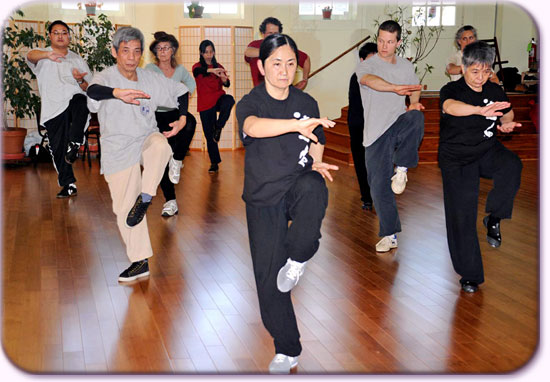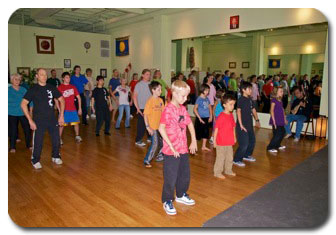Prerequisite: No previous skill is required.
T’ai Chi is a martial art characterized by slow, flowing movements of the upper body and arms, coordinated with weight shifts and steps.
T’ai Chi is a gentle yet powerful way to relax, and is a form of meditation in motion. It can improve balance and muscle tone as well as reduce stress.
Watch the Cheng-Ming T’ai Chi form
T’ai means “grand” , Chi “terminus”, and Ch’uan “fist.” [The word “Ch’uan” (or “Zhang”) will be omitted in the following text.]
Cheng-Ming T’ai Chi is derived from the “Orthodox Style” developed by the executive committee of the T’ai Chi organization at the National Academy of Martial Arts in Nanking in 1929.

It is a complete sequence synthesized from the five major family styles of T’ai Chi (Chen, Yang, Wu, Sun and Wu/Hao.) One of the goals was to preserve the essence of T’ai Chi. Extraneous and inefficient movements or techniques were discarded. As a result, every movement, transition and posture possess a usable martial application and health benefit. Great Grandmaster Wang Shu-Jin enhanced the form with Hsing-I, Ba Gua, and Zhan Zhuang. The Cheng-Ming T’ai Chi form has one hundred movements and is the foundation in training Hsing-I and Ba Gua within the Cheng-Ming martial arts system. “T’ai Chi is the root of all the roots” Great Grandmaster Wang Shu-Jin used to say, “because the T’ai Chi form contains movements and principles of Hsing-I and Ba Gua.”
We teach this form in stages, starting with the 14-step form. Its slow steady pace provides an invigorating workout while calming the mind and reducing stress and develops the calmness and suppleness essential for training in the internal martial arts. The concept of Yin and Yang is fundamental to T’ai Chi, as the body is too much of either Yin or Yang, imbalance is created and can lead to disease of body or mind. Practicing in a slow and steady pace allows the practitioner to express the beauty of the form while providing a low-impact work out to strengthen muscular, skeletal and internal organ system.
T’ai Chi is the most defensive or soft of the three internal martial arts in the Cheng-Ming system. Its techniques are all based on circular motions utilizing various hip/waist movements with an emphasis on deflecting an opponent’s force. When applied in push hands (sensing hands) drills, students begin to see the techniques from the form and understand the martial arts value intrinsic in the form.
– Download the Cheng Ming T’ai Chi Form List here (Pin Yin by Holly Chen)
– Download the Cheng Ming T’ai Chi Sword Form List here (Pin Yin by Holly Chen)
Zhan Zhuang (Standing Meditation)
Prerequisite: No previous skill is required.
All T’ai Chi classes include instruction in Zhan Zhuang which is a form of Ch’i Kung (Qigong) training to encourage the flow of energy throughout the body in accordance with the principles of Chinese Medicine. These sets are fundamental to developing proper posture and conditioning, while promoting healing.
 Zhan Zhuang emphasizes the principle of “non-action.” The meaning of “non-action” is doing one thing only without relating to other forces in action in the environment. These exercises contribute to improve concentration and combat.
Zhan Zhuang emphasizes the principle of “non-action.” The meaning of “non-action” is doing one thing only without relating to other forces in action in the environment. These exercises contribute to improve concentration and combat.
It looks extremely simple and monotonous, however, students find this challenging in the beginning, as it requires extreme concentration and heightened consciousness coordinated with breath and relaxation.
The first Zhan Zhuang set focuses on the five internal zhang organs: heart, liver, spleen, kidneys, ad lungs. The second set focuses on the Eight Extraordinary Meridians. The 3rd set focuses on the Twelve Major Meridians. In Traditional Chinese Medicine, it is believed that increasing your internal power can protect the body against both internal and external attack. Zhan Zhuang’s contribution to fighting skills is in the way it helps keep the mind and body relaxed during a confrontation.
Meditation helps open the meridians and increase the circulation of Ch’i (Qi) which will result in increased internal power. Students improve their sensitivity to both external and internal movement. Zhan Zhuang is integrated at every level of training.
Fees, Policies and Registration Information

View the Class Schedule here.
